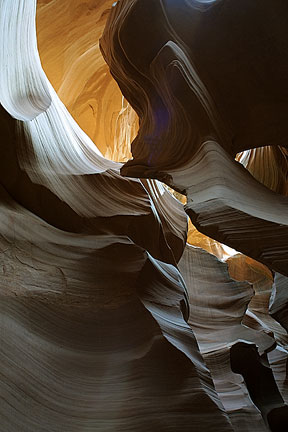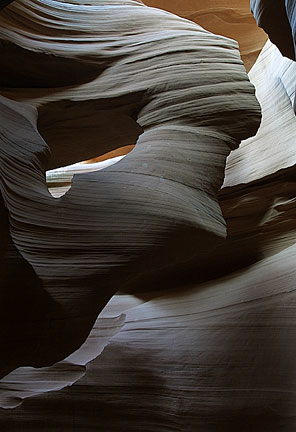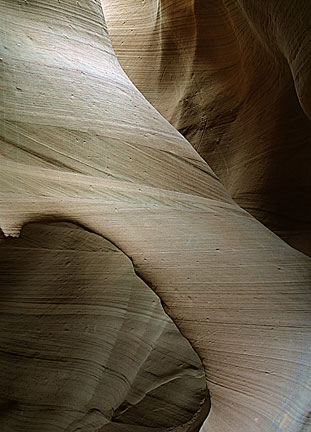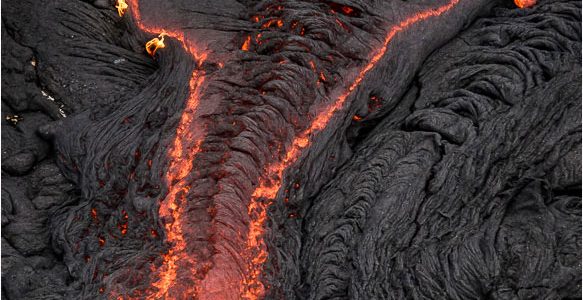This subject is featured in Issue #4 of The Luminous Landscape Video Journal.
Into The Bowels of The Earth
Few locations hold as much fascination for landscape photographers as Antelope Canyon. There are in fact two slot canyons with this name, Upper Antelope and Lower Antelope. They are located just a few hundred yards apart, just next to the Navajo Power Plant, east of Page, Arizona.
I had photographed in Upper Antelope in 1998 but was unable to visit Lower Antelope at the time because it had been closed the year before due to a flash flood which killed a number of photographers and tourists. This canyon has now reopened.

A memorial plaque dedicated to the 11 photographers and tourists that lost their lives during a flash flood in Lower Antelope Canyon in 1997.
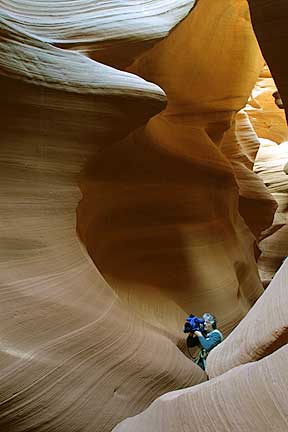
Chris in Lower Antelope
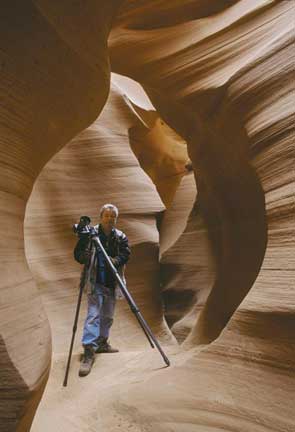
Michael in Lower Antelope
I’ve included this shot of my friend and colleague Chris Sanderson as well as one of me, taken by Steve Kossack, to help you understand the scale of Lower Antelope Canyon.
Lower Antelope is quite different from Upper Antelope. While Upper is flat and in places quite wide, and can be explored by almost anyone, Lower is extremely narrow and difficult to negotiate. Since the 1997 tragedy the Navajos who operate the site have installed permanent metal ladders which allow relatively easy access. This contrasts with the rope ladders that used to be required. But, it’s far from a walk in the park, and anyone with phobias about heights or confined places should think twice about visiting.
I first feel in love with Antelope in 1990 when I bought a B&W print shot in Upper at a gallery. I had no idea at the time where this place was, but it captivated me. Since then, though I love the color found in these canyons it’s the form that captivates me most. In the photographs below I have tried to combine both ways of seeing.
Lower Antelope 3
Photographed with a Canon EOS D30 and 14mm f/2.8 Sigma lens at ISO 100.
Photography in Lower Antelope is tough for several reasons. From a physical point of view the hike from one end of the canyon to the other and back takes at least 3 hours, stopping to do photography. Every step of the way is very narrow, and fitting through tight passages and negotiating steep long ladders with a back-pack style camera bag and tripod is hard work. I strongly recommend leaving your bag top-side and just enter the canyon with your camera, tripod and a couple of lenses in a shooting vest Ã� extreme wide-angle to moderate wide-angle are what’s needed.
You’ll also leave the Canyon in need of a neck massage. Much of the time you’ll be shooting upward, and unless you have a right-angle or a waist-level finder you’ll have quite a sore neck and shoulders.
Lower Antelope 4
Photographed with a Canon EOS D30 and Canon 17~35mm f/2.8L lens at ISO 100.
Shooting in slots canyons like Lower Antelope is also tough photographically. Contrast ranges are extreme. Holding details in highlights as well as shadows is a challenge if not downright impossible. Metering is best done with a spot meter (something that I’m used to in the EOS 1V and find sorely lacking in the D30). If you use your camera’s built-in matrix metering typically you’ll want to set the exposure to about 1.5 stops underexposure to compensate for the highlights which will otherwise burn out. Remember, expose for the highlights and let the shadows fall where they may. The D30 does an excellent job of retaining shadow detail but nothing can help blown highlights.
Lower Antelope 5
Photographed with a Canon EOS D30 and Canon 17~35mm f/2.8L lens at ISO 100.
Unlike Upper Antelope, one enters Lower without a guide. You pay your $17.50 per person, are shown where the first ladder descends into the earth, and you’re on your own. You can spend as much or as little time as you like and if you’re there at an “off” time of year, as we were, you’ll encounter only a few other people the whole time that you’re below ground. (Bring water!!)
It’s critical that you are there when the sun is directly overhead. Calculate when it’s half way between sunrise and sunset Ã� high noon. That’s the best time to be there. We arrived at the canyon at 10:30am and worked till mid-afternoon, but the best light was between 11am and 1pm. If you can’t be there at mid-day, don’t even bother going. The light will be flat and the magic will have evaporated.
Lower Antelope Canyon is now open 365 days a year, except when it’s not. (That’s what they told me :-)
Using theCanon EOS D30inLower Antelopeprovided some significant advantages. The challenge in shooting there is the extreme contrast range. The body’s rear LCD allowed for instant review of how well the selected exposure was able to contain this difficult exposure challenge. Having a histogram available, as well as the flashing display that shows which areas are beyond the exposure range of the imaging chip, is a very welcome addition.
This subject is featured in Issue #4 of The Luminous Landscape Video Journal.
updated August 2016
You May Also Enjoy...
Vietnam
By: Nick Rains Siesta time135mm ISO800 350th/F2.0Whilst my main form of photography is more traditional landscape work on large format and on film, I also
Hawaii – The Big Island
The biggest island in the Hawain chain is called "The Big Island". Why? Well, obviously because it is the biggest, but also because it is
